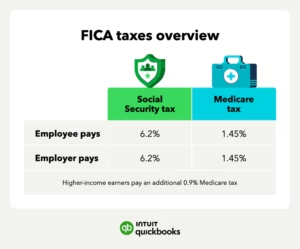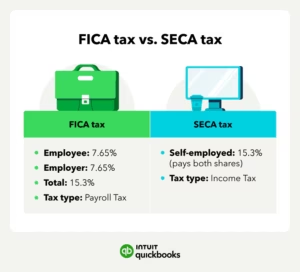By: Marshall Hargrave
FICA Tax Definition:
FICA taxes are federal payroll taxes used to fund Social Security and Medicare programs. The total FICA tax rate is 15.3%, with 12.4% allocated to Social Security and 2.9% for Medicare. Both employees and employers contribute to these taxes, each paying 7.65% of the employee’s wages.
Keeping track of all the types of payroll taxes is never easy. This includes understanding the Federal Insurance Contributions Act (FICA) taxes when trying to meet payroll tax withholding requirements. FICA taxes include Social Security and Medicare taxes for a total rate of 15.3%. Employers and employees split the FICA tax payment, each paying 7.65%. However, self-employed individuals must pay the whole FICA amount. Self-employed FICA taxes are the same as self-employment taxes, but the process for reporting and paying differs if you’re an employer versus a self-employed individual. Let’s look at exactly what FICA taxes are, the specific FICA tax rates and limits, and how to calculate and file these taxes.
The total FICA tax rate is 15.3%, which includes:
- Social Security: 12.4% (6.2% employee + 6.2% employer). This applies to earnings up to the Social Security wage base limit of $176,100 in 2025.
- Medicare: 2.9% (1.45% employee + 1.45% employer). There’s no earnings limit for Medicare tax, though an additional 0.9% Medicare tax applies to higher earners (over $200,000 for single filers and $250,000 for married couples filing jointly).

FICA Taxes vs. Self-Employed Taxes:
While “FICA taxes” technically refers to taxes withheld from employee wages, self-employed individuals pay similar taxes under the Self-Employed Contributions Act (SECA).
Here’s how they compare:
- FICA tax: This is a payroll tax deducted directly from employee wages. Employers withhold 7.65% to cover the employee’s share of Social Security and Medicare taxes, and they match that amount for a total of 15.3%.
- SECA tax: This is an income tax. It’s calculated on 92.35% of your net self-employment earnings. Self-employed individuals are considered both the employer and employee, so they are responsible for paying the full 15.3% SECA tax themselves.
Essentially, self-employed individuals pay the combined employer and employee share of Social Security and Medicare taxes.
Even though self-employed individuals pay a higher rate, they can deduct half of their self-employment tax as a business expense. This helps reduce their overall tax liability.

Other Payroll Taxes to Consider:
FICA taxes are just one part of payroll withholdings, which also include unemployment taxes. Federal unemployment tax withholding is known as FUTA, while state unemployment is SUTA.
- Federal Unemployment Tax Act (FUTA): This federal tax funds unemployment benefits for workers who have lost their jobs. Employers pay FUTA tax on the first $7,000 of each employee’s wages. The FUTA tax rate is 6.0%, but employers can receive a credit of up to 5.4% for paying state unemployment taxes, resulting in an effective FUTA tax rate of 0.6%.
- State Unemployment Tax Act (SUTA): Each state has its own unemployment tax program, with rates and requirements varying by state. Employers typically pay SUTA taxes on a portion of employee wages, which fund unemployment benefits for workers within that state.
Understanding these additional payroll taxes is crucial for employers to ensure compliance and avoid penalties.


